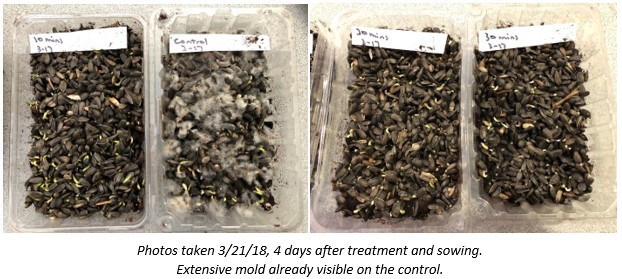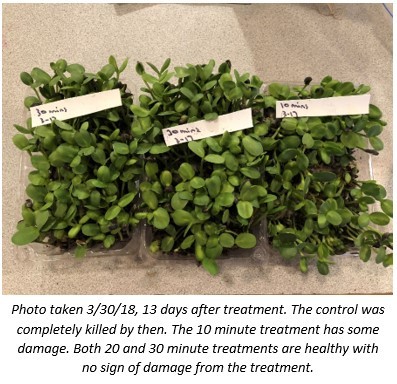Moldy Sunflower Shoots
Amy Ivy, Vegetable Specialist
Eastern New York Commercial Horticulture
A few of our growers have struggled in late winter with gray mold growing over their flats of sunflower shoots. The mold is botrytis, growing on the outside of the hulls, and it can really ruin a flat of shoots.
I have been interested in hot water seed treatments for spinach, brassicas and tomatoes and I wondered if that process might be helpful for this problem on sunflowers. Meg McGrath has detailed information on hot water seed treating at http://vegetablemdonline.ppath.cornell.edu/NewsArticles/HotWaterSeedTreatment.html Note: This process is recommended only for small seeded crops and Meg has specific temperatures and times for treating each type. But I decided to experiment a bit on my own to see if I could at least lessen the severity of botrytis on sunflower shoot production.
I had 4 treatments: 10 minutes, 20 minutes, 30 minutes (all at 122 degrees) and the 4th was the control without any water treatment. I thought the 30 minute treatment might affect germination but as you can see from the pictures, for this crop it did not. After 2 weeks all 3 water treatments were germinating well with no visible mold while the control was heavily infested.


This is not a replicated, formal research study, just a casual test that had some interesting results, so I cannot guarantee this method. But growers who have had problems with moldy sunflower sprouts might want to give this a try so see if they get similar results.
Also interesting is the device I used for the hot water treatment. Available for around $110 online, this ‘immersion circulator' was developed for cooking meat using the sous vide method popularized by Kenji Lopez-Alt, chef/author of The Food Lab and the blog Serious Eats. See: https://www.seriouseats.com/2016/01/first-thing-to-cook-with-sous-vide-immersion-circulator-essential-recipes.html for more information.

This ‘immersion circulator' device can be used throughout the year for all kinds of home cooking; and can then be put into service for hot water treating particular seeds. Ideally you will need 2 units, one to pre-heat the seeds to 100 degrees and the second to precisely treat the seeds at the particular temperature listed in Meg McGrath's publication. I particularly like the way these units keep the water moving, for more even temperatures and distribution.

Upcoming Events
Ag Labor Road Show IX
December 1, 2025 : Save the Date! - Ag Labor Roadshow Webinar 1
In addition to the in-person Ag Labor Roadshow program in our region on December 9, two webinars are scheduled for December 1 and December 22. Each webinar will focus on different program content that is different from the in-person sessions. These webinars are an added benefit to program registration.
December 9, 2025 : Save the Date - Ag Labor Road Show In-Person Event (Greenwich, NY)
Greenwich, NY
The Roadshow delivers essential updates on labor law, regulations, and workforce best practices—tailored for farm owners, managers, and ag service providers. Sessions also focus on practical strategies to boost communication, strengthen retention, and build a positive workplace culture.
The in-person session for Eastern NY is December 9 - Elks Lodge, Greenwich, NY - full day in person session
Additional in-person sessions are:
December 10 - Hilton Garden Inn, Watertown, NY, December 17 - Cornell AgriTech, Geneva, NY, December 18 - Genesee Community College, Batavia, NY
December 22, 2025 : Save the Date! - Ag Labor Roadshow Webinar 2
In addition to the in-person Ag Labor Roadshow program in our region on December 9, two webinars are scheduled for December 1 and December 22. Each webinar will focus on different program content that is different from the in-person sessions. These webinars are an added benefit to program registration.
How to Obtain a Pesticide Applicator License
December 17, 2025
Thinking about becoming a certified pesticide applicator in New York, but aren't sure where to start? Join DEC representative Kenneth Klubek for a discussion on who needs to become a certified pesticide applicator, certification types, examination procedures, and recertification. Participants will have ample opportunity to ask questions during the program.
2026 Winter Cut Flower Webinar Series
January 6, 2026 : Session 1: Cut Flower Cost Calculator Updates and Woody Cuts
Session 1: Cut Flower Cost Calculator Updates and Woody Cuts
January 13, 2026 : Session 2: Perennials and Industry Trends
Session 2: Perennials and Industry Trends
January 20, 2026 : Session 3: Anaerobic Soil Disinfestation and Biochar
Session 3: Anaerobic Soil Disinfestation and Biochar
January 27, 2026 : Session 4: Beneficial Insects and Propagation Techniques
Session 4: Beneficial Insects and Propagation Techniques
February 3, 2026 : Session 5: Fungal and Insect Pests and Market Trends
Session 5: Fungal and Insect Pests and Market Trends












































